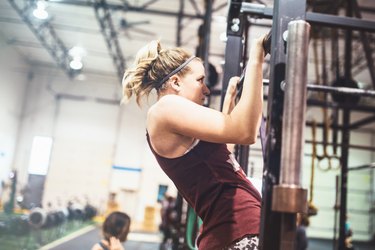
A strong back is a healthy back. Weak back muscles can lead to poor posture and back pain and can affect your performance in your favorite sport. Strong back muscles support your spine, improve your posture and enable you to bend, flex and rotate your torso with ease — not to mention, they look great come beach and pool season.
Gaining functional back strength and better muscle tone doesn't require heavy weights, just your own body weight and a few simple pieces of equipment.
Video of the Day
Video of the Day
Superman Exercise
Supermans work your entire back, strengthening the erector spinae muscles that support the spine.
How to: Lie face down on an exercise mat with your legs together and your arms extended over your head. Keeping your core muscles contracted, lift your arms, chest and legs off the mat. Hold for 1 to 5 seconds at the top, then lower back down.
Technique tips: Keep the neck long and in line with the spine. Pull the shoulder blades together. Exhale as you rise up, inhale as you lower down. Continue to breathe during the hold, taking shallow breaths. Use the back muscles rather than the glutes to power the lift.
Read more: What Are the Benefits of Back Exercises?
Marching Bridge
A variation on a static bridge in which both feet stay on the floor, this exercise ups the challenge by requiring you to lift one foot off the floor at a time. The exercise targets the stabilizer muscles of your back, including the erector spinae.
How to: Lie on your back with your knees bent and your feet flat on the floor. Extend your arms alongside your body with the palms down. Press into the feet and lift your hips up. Keeping your core contracted, lift one foot off the floor at a time, place it back down, then lift the other foot. Continue alternating, or marching in place.
Technique tips: This is also a great glute exercise, but avoid letting your glutes do all the work. If you feel your glutes squeezing together, release them. You also want to avoid arching your lower back. Once you've mastered lifting each foot a few inches off the ground, you can progress to extending the lifted leg before setting the foot down again.
Pull-Ups
Pull-ups are the go-to exercise for building strength in the latissumus dorsi, the back muscles that wrap around the sides of your torso. Start with an assisted pull-up and work your way up to unassisted pull-ups. You can use a pull-up bar or any bar that's high enough for you to hang from without your feet touching the floor.
How to: For an assisted pull-up, loop an exercise band over the bar. Pull the bottom loop of the band down and put one foot into it like a stirrup. Jump up and grab on to the pull-up bar with an under- or overhanded grip and engage your lat muscles. Pull yourself up until your chin passes the bar. Slowly lower yourself back to your starting position.
Gradually lessen the resistance of the exercise band you use until you're able to do an unassisted pull-up.
Technique tips: Wrap your free leg around your stirruped leg for more control. Don't return to a dead hang at the end of each rep; maintain the engagement of your lats and come down until your arms are almost straight, then pull back up again. Use breath control for more power — breathe out as you pull yourself up and breathe in as you lower down.
Read more: The Ultimate Back Strength Workout
Inverted Row
Inverted rows target the whole upper back, as well as the biceps. You can do them with rings or suspension trainers, but you can also use the edge of a sturdy table. If you use a table, your body will be positioned underneath the table.
How to: Grasp the rings, strap or table edge with your hands a little wider than your shoulders. Bend your knees and place your feet flat on the floor. Contract your core muscles so that your body is in a straight line from your shoulders to your knees. Bend your elbows and pull up until your chest comes in contact with the handles or table edge. Lower back down to the start with control.
To make the exercise more challenging, walk your feet further away from your body.
Technique tips: Focus on using your back muscles rather than your arms to do most of the work by squeezing your shoulder blades together as you pull. Keep your core contracted throughout the movement, and don't allow your hips to sag toward the floor. Exhale as you pull up and inhale on the way down.